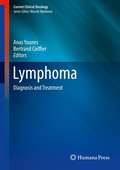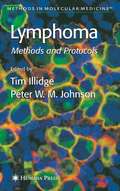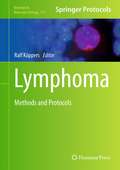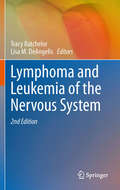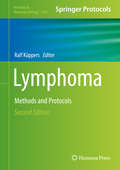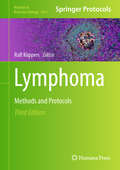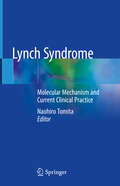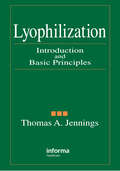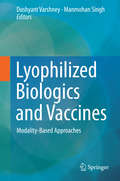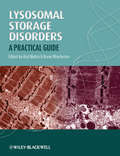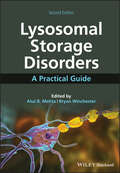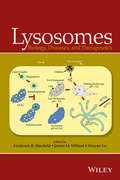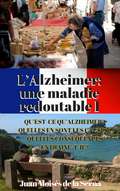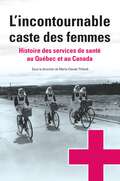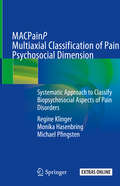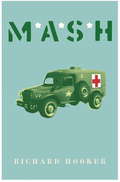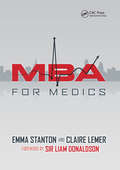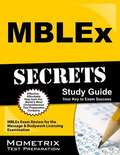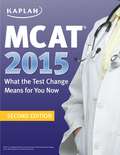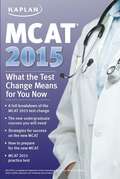- Table View
- List View
Lymphoma
by Anas Younes Bertrand CoiffierRecently, understanding the molecular pathogenesis of malignant lymphomas has led to improvement in the diagnostic precision and to the identification of a variety of molecular therapeutic targets. In addition, new drugs have been approved in the US and Europe, resulting in changes in the standard of care of several types of lymphoid malignancies. Comprehensive in scope and developed by a team of internationally renowned authors, Lymphoma: Diagnosis and Treatment provides a timely update on the most important advances in the biology, diagnosis, and therapy of lymphomas. As part of the Current Clinical Oncology series, Lymphoma: Diagnosis and Treatment will be of value to medical oncologists, hematologists, radiation oncologists, and all physicians involved in the care of patients with lymphoid malignancies.
Lymphoma
by Robert Marcus Robert Marcus John W. Sweetenham Michael E. Williams John W. SweetenhamMajor advances have occurred in the diagnosis and treatment of lymphoma in recent years. Our understanding of the molecular biology and genetics of the disease has increased exponentially, and significant imaging developments have resulted in earlier and more accurate diagnosis. The new edition of this landmark text places these advances in the context of daily clinical practice. Each chapter has been updated to reflect recent developments, including new treatment agents such as immunomodulatory drugs and the next generation of antibodies, and the increasing prognostic role of PET scanning. Results from recent large-scale clinical trials are presented, and pathology and cytogenetics are integrated into discussion of each disease entity, enabling the reader to review all the key diagnostic information in one place. Featuring many color illustrations, and written and edited by leading authorities in the field, Lymphoma provides all the information you need to diagnose and manage these complex disorders.
Lymphoma
by Peter W. Johnson Tim IllidgeA cutting-edge collection of readily reproducible molecular techniques to better understand, classify, and treat lymphoma. Among the highlights are methods to use immunoglobulin gene rearrangements as markers of clonality, to exploit patterns of somatic mutation in the variable regions to indicate at which stage transformation occurred, and to apply gene arrays to the question of biological heterogeneity in morphologically similar diseases. Research methodologies that are highly likely to become routine practice in the future, such as DNA microarray and immunoglobulin V-gene rearrangements, and measurement of minimal disease, are included. There are also molecular techniques for providing for producing novel therapeutics, such as a DNA vaccine with patient-specific sequences derived from the lymphoma in question.
Lymphoma
by Ralf KüppersLymphomas are lymphoid malignancies derived from B or T lymphocytes, and their study has been and still is paradigmatic for many aspects of cancer research. Lymphoma: Methods and Protocols presents and discusses key methods that are used in lymphoma research, partly specific for lymphoma research but often adaptable to the study of other cancers. By covering a broad variety of methods used in lymphoma research, this book will be of interest not only for hematologists, hematopathologists, and immunologists but also for scientists interested in other fields of cancer research as well as human genetics. Written in the highly successful Methods in Molecular BiologyTM series format, chapters include introductions to their respective topics, lists of the necessary materials and reagents, step-by-step, readily reproducible laboratory protocols, and tips on troubleshooting and avoiding known pitfalls. Versatile and cutting-edge, Lymphoma: Methods and Protocols serves researchers studying human physiology with the ultimate goal of understanding and controlling these often terrible diseases.
Lymphoma and Leukemia of the Nervous System
by Lisa M. Deangelis Tracy BatchelorThis is the second edition of a book called "Lymphoma of the Nervous System," which was published by Butterworth-Heinemann (B-H) in 2004. Lymphoma and Leukemia of the Nervous System is a comprehensive review of this challenging group of diseases and should be useful for the practicing neurologist, hematologist, oncologist and for any practitioner involved in the management of these patients.
Lymphoma: Methods and Protocols (Methods in Molecular Biology #1956)
by Ralf KüppersThis second edition volume expands on the previous edition with descriptions of recent developments in the field. The new and updated chapters discuss the latest approaches for studying single cell RNA sequencing, whole genome sequencing data, CRISPR/Cas9-mediated gene knockout, protein interactions by a proximity ligation assay, and detection of circulating cell-free tumor DNA in lymphomas. Written in the highly successful Methods in Molecular Biology series format, chapters include introductions to their respective topics, lists of the necessary materials and reagents, step-by-step, readily reproducible laboratory protocols, and tips on troubleshooting and avoiding known pitfalls. Innovative and thorough, Lymphoma: Methods and Protocols, Second Edition is a valuable resource for hematologists, hematopathologists, and any scientists interested in cancer research, human genetics, and immunology.
Lymphoma: Methods and Protocols (Methods in Molecular Biology #2865)
by Ralf KüppersThis detailed volume expands upon the previous edition with key methods currently used in lymphoma research, partly specific for lymphoma research but often adaptable to the study of other cancers. New chapters explore the latest approaches for single cell B cell and T cell receptor sequencing, multiplexed immunophenotyping of lymphoma tissue samples, genetic manipulation and extended culture of human germinal center B cells, genetic mouse models of lymphomas, establishment of patient-derived xenograft models of lymphomas, and more. Written in the highly successful Methods in Molecular Biology series format, chapters include introductions to their respective topics, lists of the necessary materials and reagents, step-by-step and readily reproducible laboratory protocols, and tips on troubleshooting and avoiding known pitfalls. Authoritative and up-to-day, Lymphoma: Methods and Protocols, Third Edition serves as a valuable resource for hematologists, hematopathologists, and scientists interested in a variety of topics in cancer research, human genetics, and immunology.
Lynch Syndrome: Molecular Mechanism and Current Clinical Practice
by Naohiro TomitaThis book offers a comprehensive review of Lynch Syndrome (LS), addressing both the basic and clinical aspects of this condition. Due to the recent advances in our understanding of the genetic mechanism of LS, and to new screening methods, including universal screening and/or multi-gene panel analysis, the standard treatment strategy for patients and family members of LS have been steadily improving. In this book, experts describe the disease’s manifestations, discuss state-of-the-art diagnosis and management options, and offer a cutting-edge overview of the genetic and epigenetic basis of the syndrome. Providing essential insights into this new phase in the management of LS, this book is a valuable resource not only for colorectal surgeons, but also for general gastrointestinal clinicians, gynecologists, oncologists and all basic researchers with an interest in LS.
Lyophilization of Pharmaceuticals and Biologicals: New Technologies and Approaches (Methods in Pharmacology and Toxicology)
by Kevin R. Ward Paul MatejtschukThis detailed volume brings together leading practitioners in the freeze-drying community to address recent progress, not only in new analytical tools and applications of the data derived in cycle design but also in the manufacturing of lyophilized products in the healthcare sector – whether these be therapeutics, vaccines or diagnostic products - and indeed the equipment to deliver this scale of freeze-drying. Areas of focus include analytical and formulation issues, process monitoring and control, as well as post-lyophilization analysis. Written for the Methods in Pharmacology and Toxicology series, chapters include the type of expert advice that leads to superior results in the lab. Authoritative and practical, Lyophilization of Pharmaceuticals and Biologicals: New Technologies and Approaches serves as an ideal guide for researchers working in or just seeking an update on this rapidly changing field.
Lyophilization: Introduction and Basic Principles
by Thomas A. JenningsFinding consistent, analytical discussions of processes and principles of lyophilization can be challenging and often frustrating. The first resource to gather information about the field, Lyophilization: Introduction and Basic Principles is still the book to have on lyophilization. Presenting information in an easy-to-read style, the book comprehe
Lyophilized Biologics and Vaccines
by Manmohan Singh Dushyant VarshneyThis book provides a detailed account of the most recent developments, challenges and solutions to seamlessly advance and launch a lyophilized biologics or vaccine product, based on diverse modalities, ranging from antibodies (e. g. , monoclonal, fused), complex biologics (e. g. , antibody drug conjugate, PEGylated proteins), and vaccines (e. g. , recombinant-protein based). The authors adeptly guide the reader through all crucial aspects, from biophysical and chemical stability considerations of proteins, analytical methods, advances in controlled ice nucleation and quality-by-design approaches, alternate drying technology, to latest regulatory, packaging and technology transfer considerations to develop a stable, safe and effective therapeutic protein, vaccine and biotechnology products. Lyophilized Biologics and Vaccines: Modality-Based Approaches is composed of four sections with a total of 17 chapters. It serves as a reference to all critical assessments and steps from early pre-formulation stages to product launch: Provides recent understanding of heterogeneity of protein environment and selection of appropriate buffer for stabilization of lyophilized formulations Details the latest developments in instrumental analysis and controlled ice nucleation technology Explains in-depth lyophilized (or dehydrated) formulation strategies considering diverse modalities of biologics and vaccines, including plasmid DNA and lipid-based therapeutics Details an exhaustive update on quality-by-design and process analytical technology approaches, illustrated superbly by case studies and FDA perspective Provides the latest detailed account of alternate drying technologies including spray drying, bulk freeze-drying and crystallization, supported exceptionally by case studies Provides a step-by-step guide through critical considerations during process scale-up, technology transfer, packaging and drug delivery device selection, for a successful lyophilization process validation, regulatory submission and product launch Chapters are written by one or more world-renowned leading authorities from academia, industry or regulatory agencies, whose expertise cover lyophilization of the diverse modalities of biopharmaceuticals. Their contributions are based on the exhaustive review of literature coupled with excellent hands-on experiences in laboratory or GMP setup, making this an exceptional guide to all stages of lyophilized or dehydrated product development.
Lysosomal Storage Disorders
by Atul Mehta Bryan WinchesterAwareness of lysomal storage disorders needs to be raised and there is very substantial pharmaceutical interest to do so. The disorders are often viewed as obscurities but in fact they are treatable. Enzyme replacement therapy is available for four of the disorders and will be available for a further three disorders in the course of the next year. Substrate reduction therapy is licensed for one of them but in the course of the next 12 months it will be licensed for two others and a new form of substrate reduction therapy is being introduced. These diseases present to a very wide range of physicians and paediatricians. Gaucher disease may present to orthopaedic surgeons or haematologists with splenomegaly and/or skeletal disease. However, paediatricians see the childhood variants of Gaucher disease and therefore may present it to neurologists. Fabry disease typically does not present in childhood but presents to adult physicians with end organ damage (renal failrure, cardiac disease, stroke, neuropathy, gastrointestinal symptoms). A text book would draw these divergent strands together. There is substantial scientific interest in these diseases. Gaucher is well recognised as a paradigm of a molecular illness, understood at a basic level which is treatable now with specific therapy and is likely to be treatable with gene therapy within the coming five years. New advances in small molecule therapy OCo e. g. chaperone treatment, modified antibiotics affecting ribosomal function OCo are likely to be useful for these diseases in the near future. Trials are already underway. These diseases therefore offer a fabulous platform for teaching modern clinical science from basic genetics right the way through to clinical applications. a"
Lysosomal Storage Disorders: A Practical Guide
by Atul B. Mehta Bryan WinchesterLysosomal Storage Disorders Enables readers to gain both holistic and specific knowledge on the topic of Lysosomal Storage Disorders In the past few decades, we have witnessed a ‘golden age’ of Lysosomal Storage Disorders (LSDs) clinical care, diagnosis, and research and this book is a well-timed review of the rapidly developing subject of LSDs. Contributions from many leading scientists and clinicians in the field provide the reader with a completely comprehensive overview of the subject. Topics covered in the book include: The general aspects of LSDs, with special attention paid to physiology and pathology Clinical and laboratory diagnosis, including newborn screening and the genetics of LSDs Individual LSDs, such as the various sphingolipidoses, mucopolysaccharidoses, glycogen storage disease, glycoproteinoses, galactosialidosis, and neuronal ceroid lipofuscinoses Other disorders of the lysosome, including those involving defects in the lysosomal membrane and in the emerging roles of the lysosome in cellular metabolism The existing and emerging treatments for LSDs Key patient issues such as availability and disease awareness, including in the Third World. For researchers and industry professionals in the field of LSDs, this book serves as a completely comprehensive reference work to understand both theoretical concepts and how they may be used in practical applications. For students of LSDs, it provides a solid base of foundational knowledge and serves as a practical guide.
Lysosomes: Biology, Diseases, and Therapeutics
by Shuyan Lu James M. Willard Frederick R. MaxfieldDiscussing recent findings, up-to-date research, and novel strategies, the book integrates perspectives from pharmacology, toxicology, and biochemistry to illustrate the potential of lysosomes in drug discovery and development.* Explores basic principles and properties of lysosomes that allow them to act as regulators of cell metabolism, therapeutic targets, and sites for activation of drug conjugates * Discusses the role of lysosomes in metabolism, drug targeting, apoptosis, cancer, aging, inflammation, autophagy, metabolism, toxicity, and membrane repair* Introduces new pathways in therapeutic development and new mechanisms in drug development
Líneas Carmesí
by Cole SteeleUna víctima de una picadura de insecto aparece en la sala de emergencias de Memorial Hospital infectada con un virus mortal que se cree que se ha extinguido. Mientras investiga un fatal accidente peatonal, Roman Lee descubre que los dos están relacionados con la ayuda de la Dra. Marlene Scott. El CEO de una compañía farmacéutica bajo el escrutinio del Congreso por aumentar el precio de las recetas para salvar vidas trama venganza fuera de la red en el sitio en las profundidades del Amazonas. Jaxson Lathos está desarrollando un virus dirigido a mujeres embarazadas y niños. El virus llega desde el Amazonas a los Estados Unidos por las aves migratorias infectadas. Él solo será el único con la cura y podrá nombrar su precio por la cura.
L’Alzheimer: une maladie redoutable I
by Juan Moises de la Serna Bakrim NouryIssu d’une trilogie amplement consacrée à la maladie Alzheimer, ce livre a été conçu à la base de questionnements utiles. D’emblée un mot sur ses mérites pédagogiques : le livre adopte une démarche rationnelle simplifiée qui permet à tous les lecteurs concernés de comprendre le phénomène qui les accable, partant ontologiquement de la définition très fine en passant par la causalité pour enfin aboutir aux conséquences variées. En outre, son intelligence se traduit par une articulation des questionnements ‘’populaires’’ aux grands questionnements de la recherche contemporaine sur l’Alzheimer. Pour l’avoir lu et traduit, je peux affirmer que cet équilibre est réussi. Le livre est aussi utile et fiable quand il s’agit de diversifier les références aux solutions thérapeutiques ou celles concernant les résultats de l’état de l’art actuel en matière d’Alzheimer : dans ce sens bien précis, les données sont exposées avec un sens aigu de la critique qui permet non seulement de comprendre ‘’ce qui se fait’’ aux quatre coins du monde mais aussi de pouvoir adopter une vision claire sur ‘’ce qui peut être concrètement fait’’ afin de retarder voire même de guérir la dégénérescence des fonctions cognitives de la mémoire. D’autres apports seront certainement un atout pour les lecteurs concernés ou curieux: la distinction d’Alzheimer des autres démences, où il propose même une forme de diagnostic enrichi, une nouvelle méthode de prévention/d’anticipation publique et familiale très utile pour les proches par exemple. L’accent mis sur l’inefficacité pharmacologique est une autre voie de vulgarisation où les lecteurs sauront comment se situer face aux traitements médicamenteux actuellement disponibles. Enfin, trois pistes sont suggérées où l’argumentation du livre culmine avec des propositions claires : la piste génétique, la piste biologique et la piste psycholo
L’incontournable caste des femmes: Histoire des services de santé au Québec et au Canada (Santé et société)
by Marie-Claude ThifaultSages-femmes, religieuses, sœurs hospitalières, bénévoles, infirmières de la Croix-Rouge, de colonie, militaires, en psychiatrie, assistantes sociales et professionnelles de la santé sont ici sujets de l’histoire dans le large champ des services de santé au Québec et au Canada. Plus qu’un sujet, il est ici question d’une extraordinaire caste. Soucieux de fermer le fossé linguistique qui divisa non seulement la pratique, mais aussi l’historiographie de la médecine au Canada et au Québec, l’ouvrage collige des recherches récentes dans le champ historique de la santé réalisées par des historiennes et des historiens francophones et anglophones. Une invitation à découvrir sur plus d’un siècle la place prédominante de plusieurs générations de femmes qui ont participé activement au développement du système de santé au Québec et au Canada. Pubilshed in French.
M*A*S*H: A Novel About Three Army Doctors
by Richard HookerBefore there were the movie and the television series, there was the novel that gave birth to such American immortals as Hawkeye and Trapper John, Hot Lips Houlihan, Frank Burns, Radar O'Reilly, and the rest of the 4077th MASH--a place like no place else in Korea or on earth. The doctors and nurses who worked in the Mobile Army Surgical Hospitals (MASH) during the Korean War were well trained, dedicated, and pushed to the brink. And they were young--too young to be doing what they had to do. As Richard Hooker writes in the Foreword, "A few flipped their lids, but most of them just raised hell, in a variety of ways and degrees." Meet the true-life heroes and lunatics who fought in the Korean War, and experience the martini-laced mornings, marathon hijinks, sexual escapades, and that perfectly corrupt football game that every fan of the movie will remember. It's also a story of hard work and skill in the face of enormous pressure and odds. Here is where it all began--the novel that made M *A *S *H a legend.
MACPainP Multiaxial Classification of Pain Psychosocial Dimension: Systematic Approach to Classify Biopsychosocial Aspects of Pain Disorders
by Regine Klinger Monika Hasenbring Michael PfingstenThis book offers a diagnostic tool for physicians and psychologists who want to systematically document pain within a multimodal structure. MACPainP (multiaxial classification of pain-psychosocial dimension) is a systematic, comprehensive and clinically oriented diagnostic instrument for evaluating pain-related disorders, and includes differentiated descriptions to enable syndromes to be systematized and diagnoses compared. MACPainP can be used as a professional add-on for the International Classification of Diseases ICD-10 as well as the upcoming pain classification ICD-11, released by WHO. This clearly structured book provides an easy introduction to the biopsychological aspects of pain disorders, to allow a nuanced approach to the psychological diagnosis of pain patients. It discusses possible comorbidities (e.g. depressive disorders, anxiety disorders) as well as concrete behavior-related steps for pain-related psychological and medical treatments. An essential reference for physicians and psychologists in the field of pain therapy, it is part of the learning European Pain Federation Curriculum (EFIC) of pain therapists.
MAIT Cells: Methods and Protocols (Methods in Molecular Biology #2098)
by Helen Kaipe Isabelle MagalhaesThis volume focuses on various methods used by researchers to study mucosal-associated invariant T (MAIT) cells in the aspects described below. The chapters are organized into Four Parts: part One looks at the function and importance of MAIT cells in health and disease. It covers methods to isolate and characterize MAIT cells from human tissues including liver, colon tumors, placenta and decidua, and endometrium. Part Two discusses MR1 independent stimulation, and looks at the activation of MAIT cells by different stimulatory agents. Part Three describes various methods to develop tools to analyze, monitor, and generate MAIT cells in vitro, including the production of MR1-tetramers and how they can be loaded with bacterial antigens and used for the detection of MAIT cells. The last part covers the use of murine models to study MAIT cells. Written in the highly successful Methods in Molecular Biology series format, chapters include introductions to their respective topics, lists of the necessary materials and reagents, step-by-step, readily reproducible laboratory protocols, and tips on troubleshooting and avoiding known pitfalls.Authoritative and comprehensive, MAIT Cells: Methods and Protocols is a valuable resource for anyone interested in learning more about this developing field.Chapters 9 and 17 are open access under a CC BY 4.0 license.
MASH
by Richard HookerThe book behind the hit TV series and movie.The doctors and nurses who worked in the Mobile Army Surgical Hospitals (MASH) during the Korean War were well trained, dedicated, and pushed to the brink. And they were young - too young to be doing what they had to do. As Richard Hooker writes in the Foreword, 'A few flipped their lids, but most of them just raised hell, in a variety of ways and degrees.'Meet the true-life heroes and lunatics who fought in the Korean War, and experience the martini-laced mornings, marathon high jinks, sexual escapades, and that perfectly corrupt football game that every fan of the movie will remember. It's also a story of hard work and skill in the face of enormous pressure and odds. Here is where it all began - the novel that made M*A*S*H a legend.
MBA for Medics
by Emma Stanton'Increasingly, doctors are seeing the value of learning the language of management. A number of doctors have learnt the language and skills by gaining a formal qualification such as an MBA. Many more have followed an experiential route. This book is for doctors who see the value that an education in management can bring, whether formal or informal. The ultimate reason for doctors to be ambitious and to gain a management education is not for personal gain or for more letters after their name, but for the prize of better, safer healthcare for patients.' - From the Foreword by Sir Liam Donaldson This book encourages medics preparing for management roles to think about management and business as applied to healthcare, providing key insights on the skills involved and information for those who decide to study for an MBA. It informs health professionals on how they can improve the quality of healthcare through an understanding of business and management, including key areas such as understanding and managing accounts, marketing, and influencing and managing change. Healthcare professionals undertaking - or considering undertaking - MBAs or related management qualifications such as leadership fellowships will find this invaluable reading, as will consultants who are increasingly expected to be aware of and manage budgets for services. Undergraduate and practising doctors researching the options and roles available in medical management will also find this a vital source of information.
MBLEx Secrets Study Guide: MBLEx Exam Review for the Massage and Bodywork Licensing Examination
by MBLEx Exam Secrets Test Prep StaffThis MBLEx study guide includes practice test questions. Our study guide contains easy-to-read essential summaries that highlight the key areas of the MBLEx test. Mometrix's MBLEx test study guide reviews the most important components of the MBLEx exam. The MBLEx Exam is extremely challenging, and thorough test preparation is essential for success. MBLEx Exam Secrets Study Guide is the ideal prep solution for anyone who wants to pass the MBLEx. Not only does it provide a comprehensive guide to the MBLEx Exam as a whole, it also provides practice test questions as well as detailed explanations of each answer. MBLEx Exam Secrets Study Guide includes: -An in-depth look at anatomy and physiology -A guide to kinesiology -An extensive overview of pathology, contraindications, areas of caution, and special populations -A breakdown of benefits and physiological effects of techniques that manipulate soft tissue -An examination of client assessment, reassessment, and treatment planning -A detailed guide of the overview of massage and bodywork modalities/culture/history -An analysis of ethics, boundaries, laws, regulations -A comprehensive review of guidelines for professional practice -Comprehensive practice questions with detailed answer explanations It's filled with the critical information you'll need in order to do well on the test: the concepts, procedures, principles, and vocabulary that the Federation of State Massage Therapy Boards (FSMTB) expects you to have mastered before sitting for the exam.
MCAT 2015: What the Test Change Means for You Now
by KaplanBig changes are coming to the MCAT in 2015, and Kaplan is here to help you prepare for them.With four brand-new sections, 80% more questions, and the addition of new science content including biochemistry, psychology, and sociology, the 2015 MCAT will be a completely different test. In order to be prepared you need to understand the exam and start planning for it now, and this guide is the first step.MCAT 2015: What the Test Change Means for You Now is your complete guide to the new exam, with outlines of both old and new subject areas, a short-form practice test to help you get ready, and advice on choosing and prepping for the MCAT thatâ TMs right for you.
MCAT 2015: What the Test Change Means for You Now
by Kaplan Publishing StaffBig changes are coming to the MCAT in 2015, and Kaplan is here to help you prepare for them. With four brand-new sections, 80% more questions, and the addition of new science content including biochemistry, psychology, and sociology, the 2015 MCAT will be a completely different test. In order to be prepared you need to understand the exam and start planning for it now, and this guide is the first step. MCAT 2015: What the Test Change Means for You Now is your complete guide to the new exam, with outlines of both old and new subject areas, a short-form practice test to help you get ready, and advice on choosing and prepping for the MCAT that's right for you.
